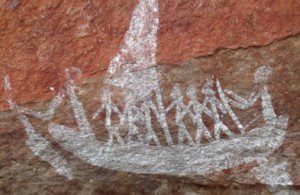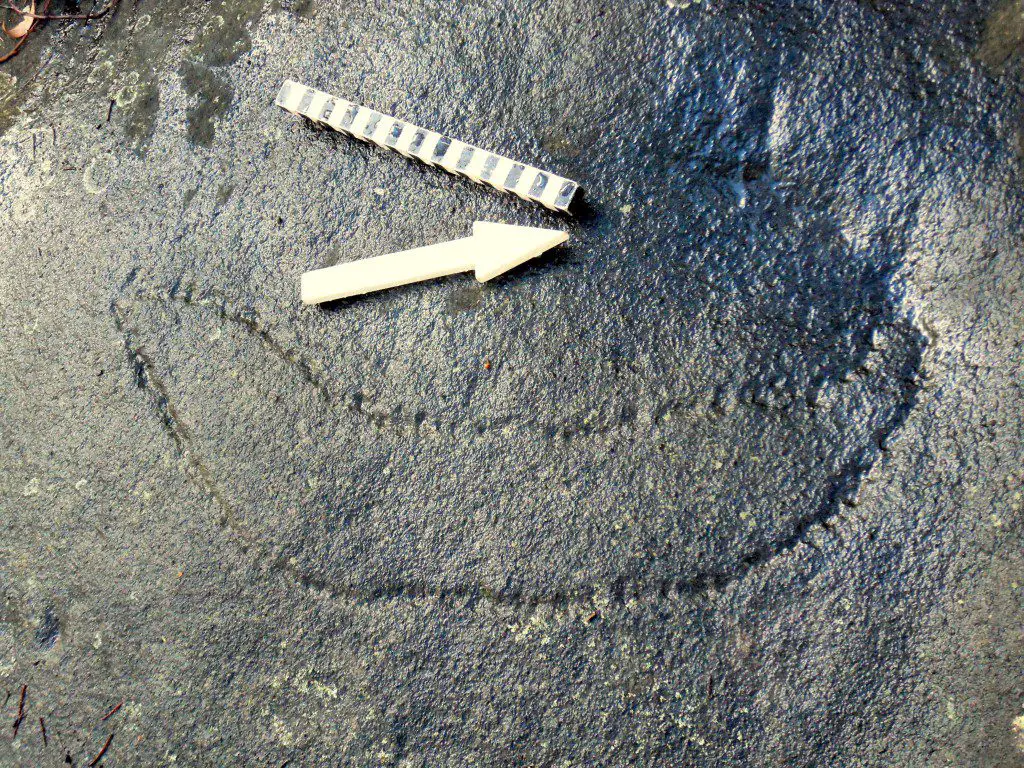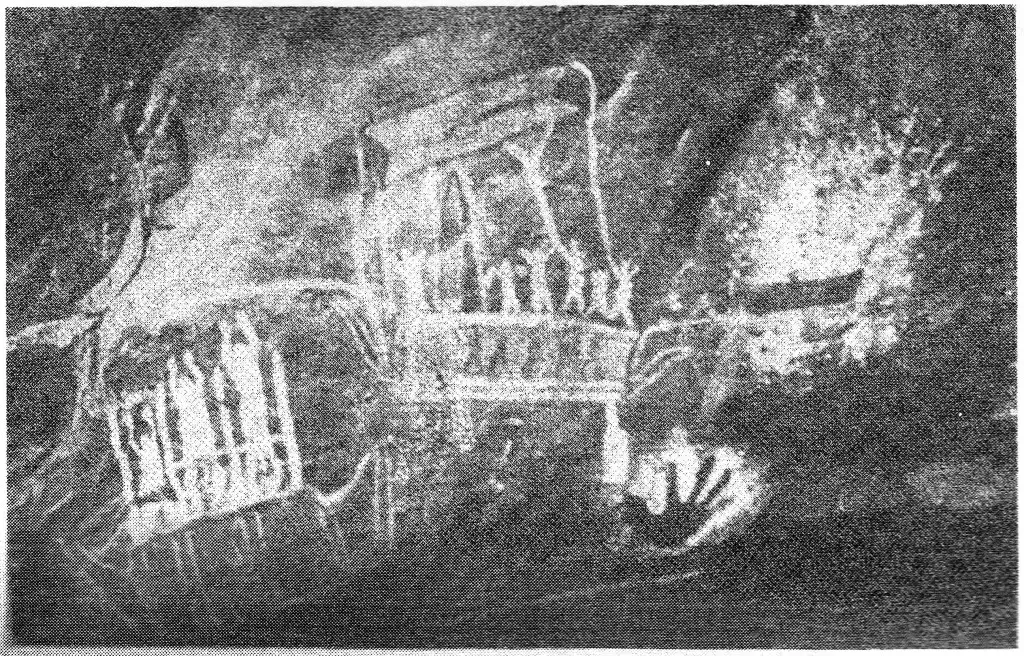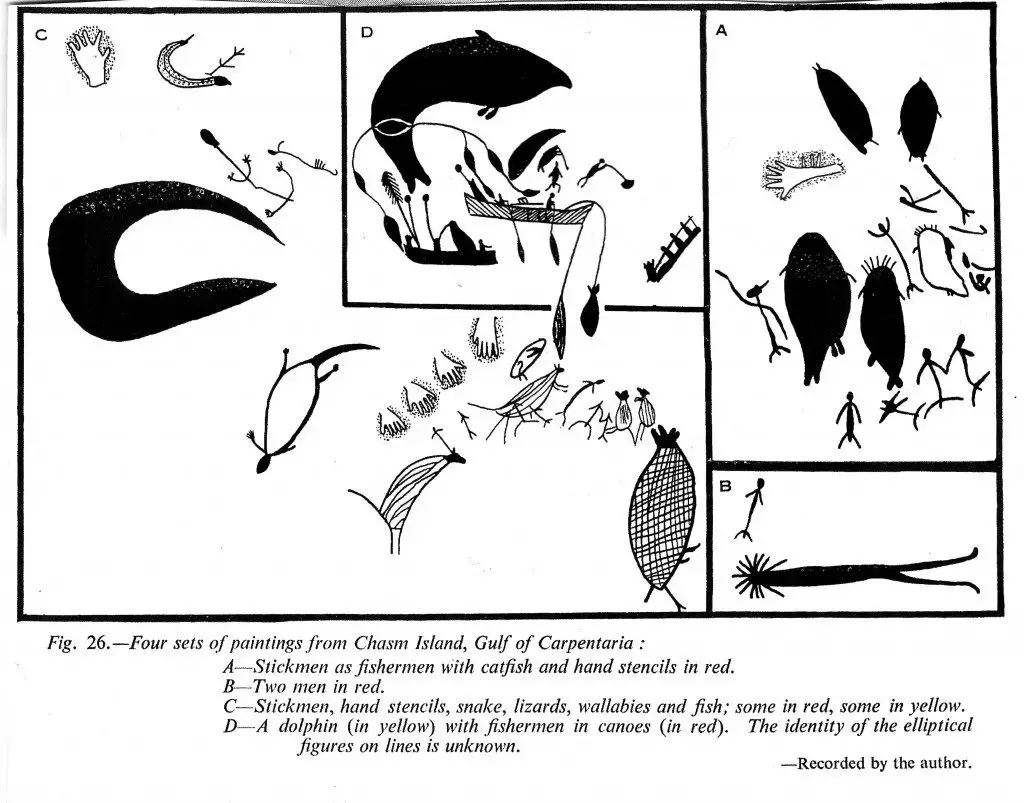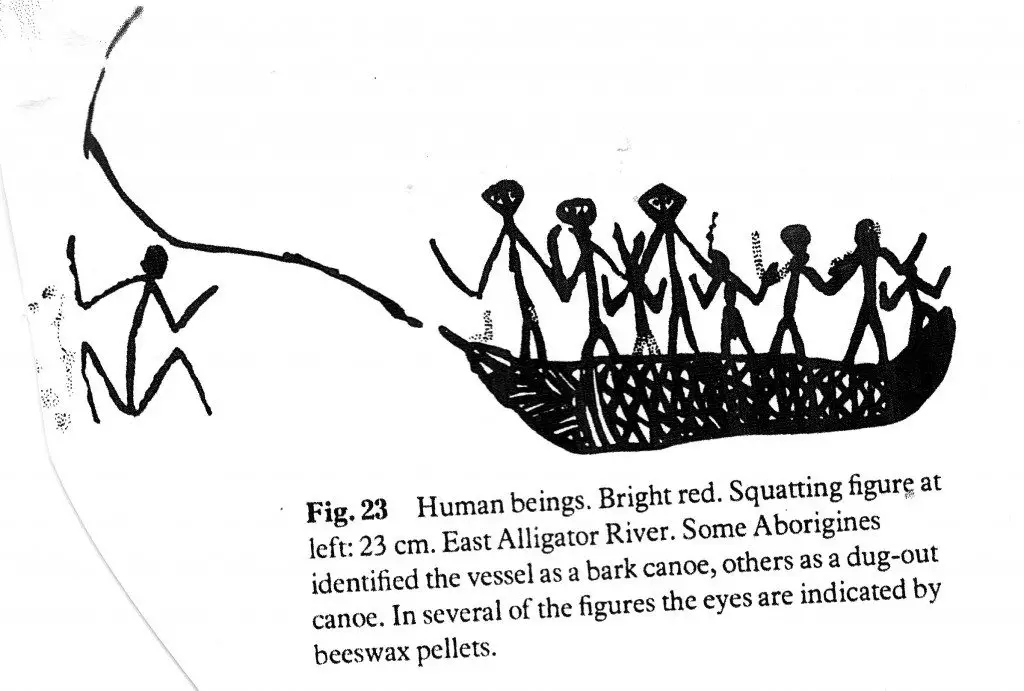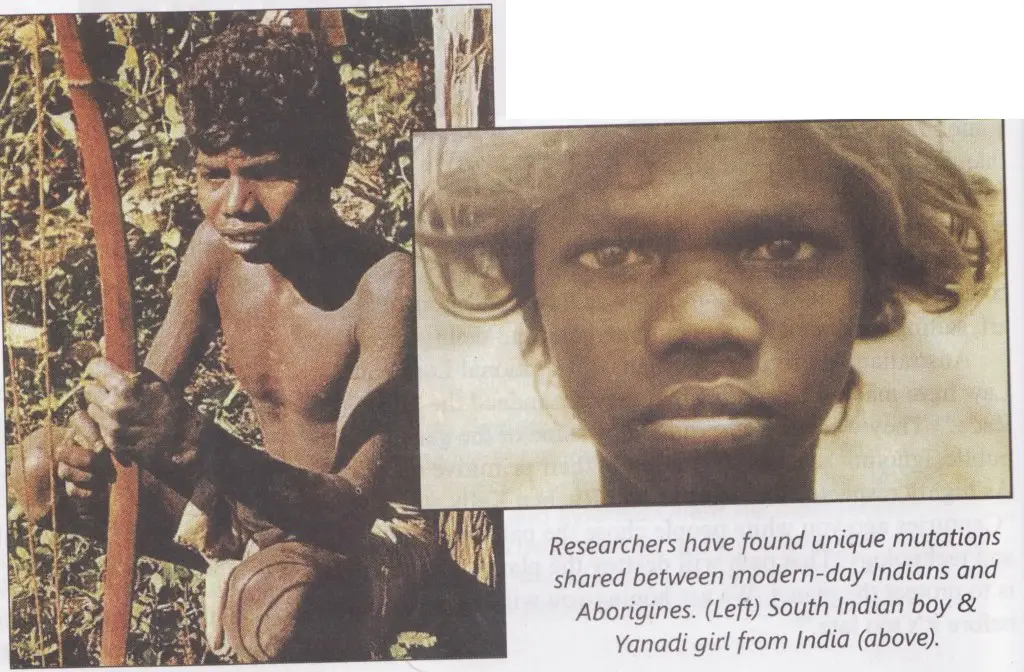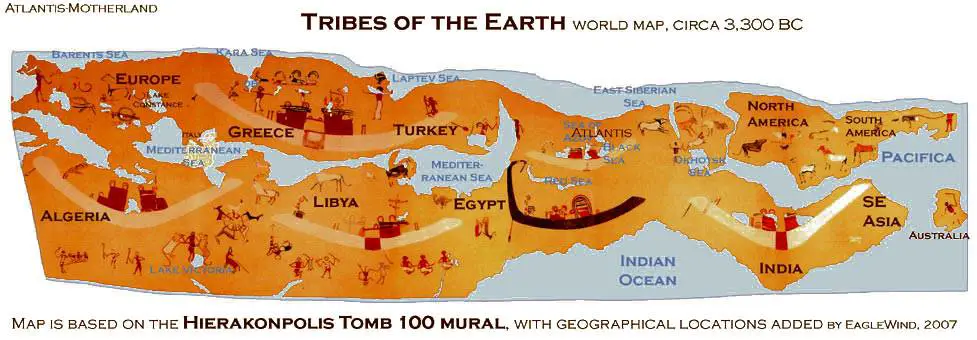By Steven Strong with Andy Whiteley
Contributing Writers for Wake Up World
Warning: Aboriginal and Torres Strait Islander readers are warned that this article may contain images of deceased persons.
Although the archaeology supporting the existence of huge ancient ocean-going boats sailing from Australia was addressed some time ago, we received a few comments from our readers about a (perceived) lack of Original boats capable of sailing across open seas, raised as evidence that Original people could never have left and settled anywhere else at any time in history.
Although we addressed these academic objections at the time, referring to both genetic and historical evidence, it is apparent this issue needs further attention in the public sphere.
[pro_ad_display_adzone id=”110028″]
The logic of those who express such doubts is simple: if it wasn’t sighted since the British Invasion, it could not have existed before it. The flaw in this reasoning relates to the fact that there actually is ample archaeological evidence found throughout the country, and many other locations off-shore, that substantiates the use of massive ocean-going boats by ancient Aboriginals.
And as is so often the case, this story of ancient Original boats sailing throughout the globe begin somewhere near Gosford NSW – the area Darkinoong Elder Auntie Beve calls ‘the Beginning Place’.
The Boats with No Names
According to academics, the pecked image we stood directly above just shouldn’t be there! Many historical texts and esteemed scholars stand united in their mistaken belief that the Aboriginal people neither designed nor constructed boats capable of reaching distant shores. Nevertheless, there lay an ancient pecking of a boat bearing a high bow and stern, which could serve no other function but to sail a considerable distance across high seas.
We had been shown photographs of this pecking, positioned within a broad expanse of bush we have agreed to refer to as ‘within 2 hours from Sydney’. But until we actually stood on site there were always questions lingering in the background. Was it merely a somewhat unusual natural formation, a recent disrespectful addition, or maybe a clumsy form of boomerang? Could it even be found again?
As soon as we arrived on site, it was obvious that none of the above applied. We located the pecking without difficulty, situated on a rock platform alongside other Aboriginal carvings. It is most definitely not natural and is clearly very old. If this carving is indeed meant to represent a boomerang, it displayed all the aerodynamic properties of a stick lying on the ground. The angle of incline at the front and back, depth and symmetry of design — the shape of the bow could have no other function but to negotiate high seas. And the rock platform on which it was pecked is situated less than 500 metres from the ocean.
Undoubtedly, all factors point well out to sea. But did this pecked boat stand alone? Further research was needed to flesh out the possibilities.
Our guides from a previous expedition into country, Angel John Gallard and Evan Yanna Muru, had provided us with over half a dozen diagrams and photographs of boats, all from the Top End of Australia, each exhibiting features that are only required if intending to sail considerable distances out into the open sea.
However, this apparent confirmation is accompanied by one very convenient academic caveat. Despite their obvious lack of similarity to any Macassan boat structure, the arrival of Indonesian fishing boats into Australian waters is claimed to be the origin and motivation behind these Original maritime records. The accepted assumption is that Indonesian fishermen sailed along the northern coast of Australia to catch trepang (sea slugs), and that the Original peoples’ familiarity with these boats (and sailors) over the past few centuries led to the engravings and ochre paintings that record their presence.
As self-serving and snugly as this assertion fits into existing theories of Aboriginal pre-history and the supposed technological stagnation of Aboriginal societies, the evidence seem to contradict this assertion, suggesting instead that the roles and geography attributed to official historical assumptions were actually reversed.
They Came, Painted… and Left Without a Trace?
First up, any engraving, pecking or painting of a boat originating from one part of the Top End – an area of north Western Australia known as the Kimberleys – can not be Macassan. According to government records, the Indonesian sailors had decidedly unfriendly relations with all tribes of this region, regarding them as “treacherous and hostile” and “extremely fierce”. Without exception, historical sources for the Kimberley area describe a hostile relationship between the Indonesian and Original people, some of which ascribe the source of hostilities to be the Original theft of Indonesian canoes.
Irrespective of why the interaction was so rancorous, it is undeniable Sue O’Connor and Steve Arrow were correct in noting a complete “absence of Macassan prau in the Kimberley rock art”. When assessing the credentials of the claims made by rock art expert Graham Walsh in relation to both the boats found depicted on cave walls and the Original artworks known as the Bradshaw paintings, the only point of consensus is that they are not about, nor created by, the Macassans. And therein lays the problem; not only is the inspiration of boat paintings in the Kimberleys not Macassan, the absence of Macassan influence suggests these boat peckings represent a people and a timing that historians will have a great deal of trouble accepting.
Walsh was an earnest character and a somewhat dogmatic self-proclaimed expert on Kimberley rock art. and his public announcement detailing his ‘discovery’ of the paintings of two “massive”, “ocean-going boats” crewed by 23 and 29 people, created an unsettled state of scholarly affairs. He could find no alternative, beyond anonymity and ambiguity, that did not challenge the accepted notion of humanity’s African ancestry. And, causing further academic collateral damage, Walsh also remained adamant that these sophisticated boats were painted no less than 17,000 years ago, although he suspected the upper limit of 50,000 years to be more likely.
The implications are as damaging to accepted theory as they are widespread; if indeed boats of such dimension and sophistication were sailing out of Australia close to 50,000 years ago, the ‘Out-of-Africa and into Australia 50-60,000 years ago theory’ of humanity’s evolution come under immediate (and well deserved) scrutiny.
Walsh felt this totally unexpected display of maritime technology, coupled with the proportions and artistic sophistication of the Bradshaw figures, was indicative of far more superior hands and palettes than what was assumed of the Original people. But rather than question accepted beliefs of the Original peoples’ artistic and technological capabilities, Walsh proposed that an unknown race, separate from the proposed African migration to Australia 60,000 years ago, sailed to the Kimberleys, set up camp, painted ocean-going boats and human figures on cave walls, then very soon after departed, never to be seen again.
Logically speaking, history must surely cast doubt on such a hypothesis. Since this unnamed race presumably returned to their original homeland, no knowledge and evidence of this monumental feat (which had no maritime parallel until perhaps 8,000 years ago) has surfaced from anywhere in the world until today.
Culturally speaking, Walsh’s assertion was as offensive to the Original people as it was condescending. His blanket denial of Aboriginal participation upset many Original custodians, and was ultimately a key factor in Walsh leaving first the Kimberleys, then the country. And, compounding the cultural affront, Walsh treated the slides and location of the two “totally alien” boats as personal property, and refused to share or discuss them.
Fortunately some of Walsh’s lesser discoveries remained in the public domain. One such boat, also bearing a high bow and stern which would serve no purpose in still waters, has a crew of four seated Bradshaw figures with two men (who appear very Aboriginal in features) dancing outside the boat. According to experts, the style and figures depicted, irrespective of whether they are imported or evolved independently within Australia, ceased 17,000 years ago. With Australian/Macassan contact limited to a time period of no more than 500 years, this boat has to have been crewed by either Australian Originals or Walsh’s hypothetical phantom race who disappeared without a trace.
These Engravings & Paintings are Not Praus
Given the timeline suggested by the style and figures depicted, we are far from convinced that all the painted and engraved boats that feature in northern Australia are the result of visiting Macassan boats, even in the areas where Originals and Indonesians maintained amicable relations.
The Macassan boats are called praus and have very unusual features, with sloping triangular sails fastened to between one and three central masts. There are many Aboriginal paintings and engravings that clearly depict this style of boat, but equally many others that bear no resemblance. Within the assortment of visual records supplied by Angel John and Evan, none have a sloped sail, a mast or masts in the centre of the boat, or the distinctive Macassan coiled rope tied to an anchor attached to the bow.
What they did provide us was an image of a huge boat engraved on rock in Arnhem Land. Featuring a crew of thirteen standing above and below deck, six masts supporting four sails and a massive rudder, and accommodations below, this boat was designed to sail across the seas. Such a huge rudder, or indeed any rudder, has never been depicted as part of any Macassan boat.
So too, a painting in the Gulf of Carpentaria shows a drogue stone attached to the stern of a boat, something that was never used by Macassans. The drogue stone is an ancient relic of a time used on boats to assist in stabilising the vessel during extremely heavy seas. It was an essential accompaniment to any boat intending to sail in open waters until about 3,000 years ago.
Interestingly, the drogue stone features not just in the Gulf of Carpentaria paintings but also in a sand sculpture of a boat at Howard Island.
Ultimately, it really doesn’t matter whether the Macassans or Walsh’s mysterious immigrants are assumed to be responsible, nobody has ever claimed that either group frequented the Sydney/Gosford region. Until now, every engraving or painting of a substantial boat capable of crossing oceans was found thousands of kilometres to the north of Sydney, but with the parameters now extended so dramatically – across the continent – presently accepted theories can obviously no longer apply.
Perhaps it is time to stop scanning distant horizons for inspiration and look for answers within our own shores?
The Winch at Ballina
Discovered by Patty McKenzie and her husband in the middle of the Richmond River, Ballina NSW (on the east coast of Australia) is what we believe to be a stone winch, once used to hoist and lower a boat’s sails in the open waters. Of course this only adds to the difficulties any advocate of the academic status quo must overcome. Having held and measured the winch, and in my opinion it has been shaped by continual wear, most likely through the actions of rope or twine rubbing against the middle section of the rock. Examining the markings, it is still possible to make out the patterning of the rope/twine. When coupled with a rather bizarre stone rudder of 45 cms (18”) in length that Patty also was found alongside the winch, it becomes obviously this is not a natural formation – and the chances increase that these objects were used to sail a boat of considerable refinement.
Both artefacts were found less than 2 kilometres from the ocean, at the deepest section of the river, and are heavy and sturdy enough to be used to secure oyster traps in the middle of the river. If they were not used to assist in raising sails in ocean winds, we are at a loss to fathom what other function these artefacts might have served.
Same Shape, Same Slope, Same Purpose…
The pecked boat found within 2 hours of Sydney stands apart in location, but certainly not in design. The design of the boat depicted at East Alligator River in the Arnhem Land region of the Northern Territory (Australia) bears near-identical shape, design and angle to the pecking into the rock platform thousands of kilometres to the south.
Lacking in Macassan sail or mast, the boats found at East Alligator River and ‘within 2 hours of Sydney’, and many others, have high sloping bows and sterns which serve no purpose in stiller waters. It would be a huge waste of time and effort to build such a complex vessel then merely fish in rivers or close to the coast where the option of choosing calmer conditions was available. A crude raft, dugout or logs bound together were far easier choices – and were often engraved or painted on walls.
The boat found near Sydney is not in that category. This boat was designed to sail much further and negotiate bigger waves. This must surely debunk any misguided theory that every image of a boat depicted (outside the Kimberleys) on a continent with a 50,000+ year history is of recent Macassan inspiration.
Original Genetics, Bones and Boats… Across the Pacific Ocean
Given that there were ancient boats in Australia, such as those of the Sydney region and East Alligator River, with a capacity to cope with high seas and sail long distances, it would appear many other apparent unanswered questions and inconsistencies arise.
In answer to a focus question from the front cover of Issue 35 of the Australian science magazine Cosmos, “Did Aborigines (sic) discover America more than 11,000 years ago”, we would suggest that the answer is yes. With literally hundreds of bones recovered throughout America, which respected scientists claim to be of ancient Original descent, many experts are no longer debating whether the First Australians sailed to this distant continent, but are more interested in recalibrating their entry date – a date which appears to be much older than previously thought.
Of course, if Aboriginal people did sail from Australia all the way to North America, there should be proof of this and many other shorter journeys throughout the Pacific Ocean.
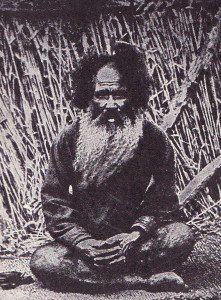 Dr. Hermann Klaatsch, a German anthropologist and academic who introduced the notion of on-field studies to European universities in the late 19th century, spent considerable time in Australia and throughout Asia gathering evidence in support of his belief that the Australian Aboriginal people were the founding race for most peoples of the world. The photograph he took of an Ainu Elder highlighted the obvious physical similarities to the Australian Aboriginal people, and just as importantly, highlighted this lone Elder’s defiant abstinence. Being of full descent and regrettably the last of his line, according to his sensibilities, all women of his tribe were of mixed descent and he refused to father any children. His existence and genetic ancestry are yet further reminders of the distance sailed by ancient Australian Aboriginal mariners.
Dr. Hermann Klaatsch, a German anthropologist and academic who introduced the notion of on-field studies to European universities in the late 19th century, spent considerable time in Australia and throughout Asia gathering evidence in support of his belief that the Australian Aboriginal people were the founding race for most peoples of the world. The photograph he took of an Ainu Elder highlighted the obvious physical similarities to the Australian Aboriginal people, and just as importantly, highlighted this lone Elder’s defiant abstinence. Being of full descent and regrettably the last of his line, according to his sensibilities, all women of his tribe were of mixed descent and he refused to father any children. His existence and genetic ancestry are yet further reminders of the distance sailed by ancient Australian Aboriginal mariners.
Evidencing the spread of Aboriginal people and their genes by ocean-going boats, but even further afield, was the recent public announcement of the discovery of another branch of hominids (Denisovans), and the accompanying analysis of the mtDNA of one individual dated to be between 30,000-80,000 years old. This specimen presents yet another race outside Australia that exhibits the same Aboriginal ancestry. Deemed to be neither of modern stock nor part of the Neanderthal family, the resulting mtDNA extracted from the finger of this Siberian girl did provide one distant location: Papua-New Guinea. Until 8,000 years ago, this island was part of the greater Australian mainland, called Sahul, and always separate from the Asian mainland and islands. Such a distant genetic connection could only occur through direct and intimate contact between two groups separated by thousands of kilometres of land and ocean, and had to involve boats of considerable size.
The problem is that the technology required to construct a boat capable of moving a viable population – one large enough to negate issues of in breeding – to another continent is claimed to be the sole province of Homo sapien sapiens, thought to have first taken place when African settlers entered Australia. But if that were so, how could these inferior, non-sapien hominids from PNG manage to make contact with the people of Australia at least 30,000 years ago? And if they were not be responsible for building large boats due to a presumed lack of intellect, as most scientific theories maintain, then that agreed limitation reverses the direction and carries with it the implication that this contact was initiated by Australian Aboriginal people sailing from the northern coast of their homeland.
Whether sailing across the oceans was the activity of homo sapien or the ‘lesser’ hominid, it stands in defiance of the accepted version of global pre-history. But for defenders of the traditional accounts of pre-history, and not just of Australia but the world, there is a more ancient genetic ‘road block’ ahead….
Far and Wide
Discovered in Siberia, the Denisovans were first assumed to be restricted to the north-eastern section of the Asian mainland. But the hominid’s genetic influence shows that they also lived in Spain. Coupled with their undisputed age of 400,000 years, this asks questions that demand new Original protocols and academic parameters. The hominids’ closest genetic match is the Original Homo sapien sapiens of Australia, which is a fundamental contradiction. The modern race of humans are widely believed to have come into existence 50,000 years ago. The mathematics and genetics simply do not add up.
The overriding question is simple: How can the Denisovans, a lower order hominid species, be most closely related to the Original people who belong to the highest order of hominids, if according to every accepted theory neither the Original Australians (once established in this continent) nor any species of Denisovans could make boats capable of sailing across oceans? According to the rules of accepted academia, the two could never meet face to face – but they did.
From a 1999 study Morphological Affinities of the Earliest Known American:
The idea that East Asia was occupied by an Australian-like population by the end of the Pleistocene [epoch] has gained more support recently. Matsumura and Zuraina (1999) described a very well-preserved skeleton from Gua Gunung, Malaysia. The specimen is aged 10,200 B.P. and is said to be a late representative of a non-specialized morphology, similar to Australian Aborigines, in East Asia.
Adding further strength to the probability that Aboriginal mariners were sailing throughout the Pacific Ocean rim thousands of years ago, an ancient Aboriginal presence is not restricted to the northern region of Asia or southern Spain; it can be found throughout the entire planet.
Thousands of kilometres to the west another Aboriginal skeleton was found, and the exploratory work of Dr. Raghavendra Rao and his associates resonates to the same Original southern genetic pool. Reported, then conveniently forgotten, Dr. Rao and his team compiled a mtDNA study on 996 individuals from 26 Indian “relic populations”. They identified “certain mutations in the DNA sequences of the Indian tribes that we sampled that are specific to Australian Aborigines”, of which seven people “shared genetic traits only found in Aborigines”. If these genetic traits are only found in Australian Aborigines, the question immediately arises in relation to how ancient people separated by thousands of kilometres of ocean managed to meet. Again, we return to the only apparent explanation — a boat.
The same situation recurred again recently regarding an ancient map kindly shown to us by ancient cartographer Patricia Awyan, which she claimed to be over 5,000 years old. We were quite taken by many aspects of the ancient Egyptian map Patricia presented on screen, but none more than the icon that represents the southern continent: a male brandishing a boomerang. No civilization beside the Australians Aboriginals hunt with boomerangs, and in the absence of world travel, ancient Egyptians should not have known that – and yet here was an actual Egyptian drawing that included one. (The fact is, many boomerangs were found in Tutankhamuns’ Tomb!)
Above all other clues, this ancient map also showed a coast-line that was remarkably close to the real thing. A couple of coastal areas are not as pronounced as they appear in modern maps, but the overall similarity to the shape of the Australian continent defies coincidence.
this artefact .
In general terms, this is a 5,000 years old map compiled by ancient Egyptian mariners, featuring an accurately shaped Australia and an Original man holding a boomerang for its icon. And once again, we cause another problem for proponents of current theory and return to the only reasonable explanation — a boat.
The Final Word
Genetics can reveal neither geography nor point of departure, but as it was with the Siberian and Spanish Denisovans, shared genetic signatures reveals the kind of personal interaction that necessitated face to face contact and the assistance of a boat. As to who instigated this contact, again it’s a 50/50 call. However, when we factor in the appearance of Aboriginal bones in Malaysia and throughout America, the photograph of the Ainu Elder, the pecked image of a boat found within 2 hours from Sydney, and Patricia’s ancient map, the chances Australian Aboriginals sailed to other continents strengthen considerably.
We began this report by stating that a pecked image of a boat shouldn’t be there, but it is. But for some reason, there is no ‘accepted’ account of why this is so and most academics will not look for one beyond the bounds of accepted beliefs. But for those trying to come to grips with Aboriginal occupation in America, Siberia, Japan, Malaysia, India or anywhere else in the Indo-Pacific Rim, any so-called anomalies are merely the result of a boat-less perspectives. The central and missing ingredient in nearly every ‘accepted’ version of Aboriginal pre-history is the boat. There is considerable evidence that before Out-of-Africa, there was a much earlier exodus, Out-of-Australia. But despite its demonstrable history in Original culture, how boats were constructed and used, and the impact and guidance Original travellers had on ancient global affairs, have never been acknowledged or appreciated.
To quote Aboriginal Elder Robert Lawlor, author of the well researched and inspiring book Voices of the First Day: “All other people of the world come from us”.
Of one thing we are now certain; the engraved boat is just one small chapter of an ancient legacy of epic proportions. So much Original culture, heritage and lore may have been forgotten by many, but it was never lost. It is all still there…. but only if we are able to stop, see and listen, the Old Way. The rock art and archaeology found ‘within two hours of Sydney’, the far north coast of NSW, the Snowy Mountains and other locations bear witness to a completely different history than the one we are taught – a history steeped in ancient Original truths, and supported by rock-solid archaeology and science.
About the authors:
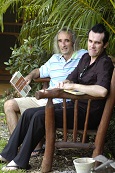 Steven Strong is an Australian-based researcher, author and former high school teacher. Together with his son Evan, his work is to explore the ancient story of the Original people, a narrative that was almost lost to aggressive European colonisation.
Steven Strong is an Australian-based researcher, author and former high school teacher. Together with his son Evan, his work is to explore the ancient story of the Original people, a narrative that was almost lost to aggressive European colonisation.
Edited and additional commentary by Andy Whiteley for Wake Up World.
This article © Wake Up World.
[pro_ad_display_adzone id=”110027″]

